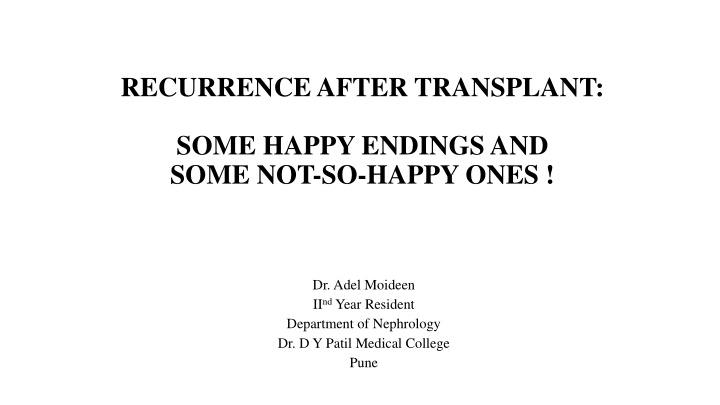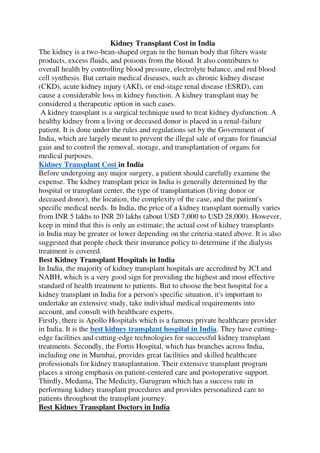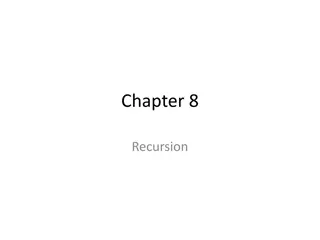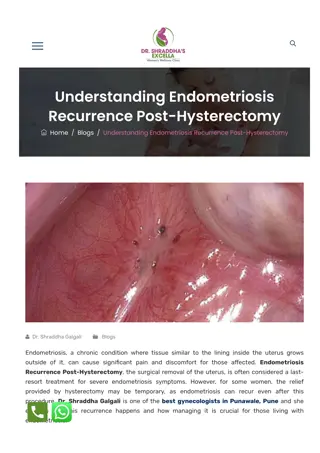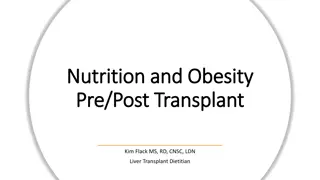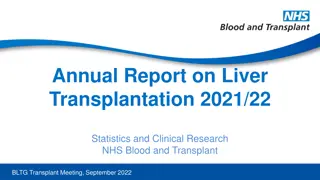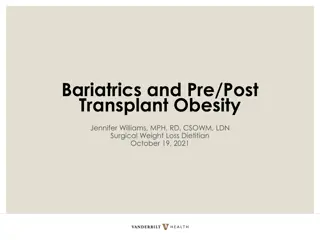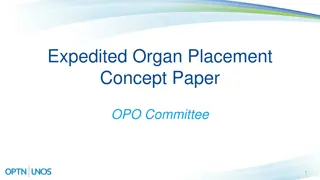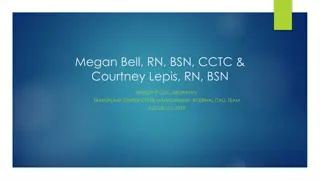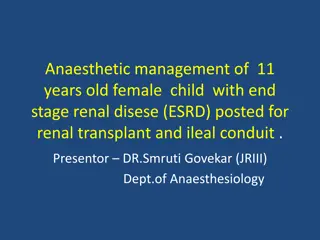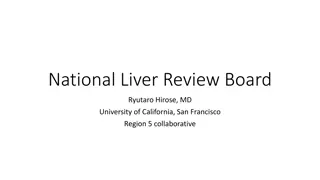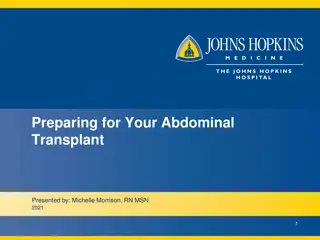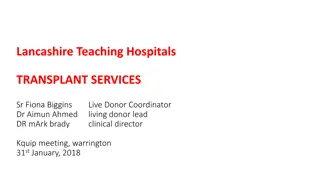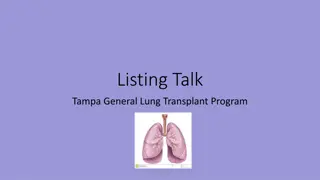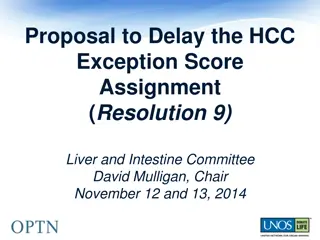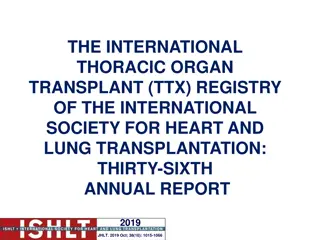Recurrence After Transplant: Clinical Case Review
A detailed case study of a 24-year-old male with a history of CKD stage V and chronic glomerulonephritis who underwent a renal transplant from a live donor. Initial post-transplant period showed stability, but the patient faced challenges with follow-up leading to on-and-off fever, decreased appetite, and weakness due to unreliable drug compliance. Current investigations reveal signs of renal dysfunction. Management and further intervention are crucial for the patient's well-being.
Download Presentation

Please find below an Image/Link to download the presentation.
The content on the website is provided AS IS for your information and personal use only. It may not be sold, licensed, or shared on other websites without obtaining consent from the author.If you encounter any issues during the download, it is possible that the publisher has removed the file from their server.
You are allowed to download the files provided on this website for personal or commercial use, subject to the condition that they are used lawfully. All files are the property of their respective owners.
The content on the website is provided AS IS for your information and personal use only. It may not be sold, licensed, or shared on other websites without obtaining consent from the author.
E N D
Presentation Transcript
RECURRENCE AFTER TRANSPLANT: SOME HAPPY ENDINGS AND SOME NOT-SO-HAPPY ONES ! Dr. Adel Moideen IIndYear Resident Department of Nephrology Dr. D Y Patil Medical College Pune
CASE - 1 HISTORY 24y/ Male/ Nov 2014 - C/o giddiness, nausea and vomiting, DOE, pedal edema and decreased U.O On presentation, BP 160/100 mm of Hg Urea-80mg/dl, S.Creat4.0 mg/dl; Urine R/M- Protein-+++, RBC-2-3/ hpf, Pus cells-0-1/hpf, UPCR-2.5; viral markers and autoimmune workup - negative; Opthalmology & ENT evaluation-normal.
HISTORY (Contd) USG KUB s/o B/L small, shrunken kidneys ( RK 7.3 x 3.5cm & LK 8.0 x 3.7cm) with loss of CMD. Diagnosed with CKD stage V/ ? CGN; maintained on conservative management. Lost for F/U; Jan 2015 - dyspnea, hypervolemia, pedal edema and HTN Urea-164mg/dl and S.Creat -9 mg/dl Initiated on hemodialysis; thrice weekly maintenance hemodialysis/ Right IJV tunneled perm-cath as access.
HISTORY (Contd) Worked up for renal transplant; his father underwent pre-transplant work up and was found to be fit as donor. Underwent live related renal transplant on 08/06/2015 (3/6 mismatch) No induction (financial reasons); On Triple immunosuppresion therapy : Tacrolimus, Mycophenolate sodium, Prednisolone. Discharged on POD-10 with baseline S.Creat of 1.1mg/dl. Asymptomatic for next 2 years with stable S.Creat and Tac levels; but lost for F/U again for the next 7 months.
HISTORY (Contd) Feb 2018 - c/o on & off fever, decreased appetite and generalised weakness since 15 days (unreliable drug compliance). O/E - Conscious, Oriented, afebrile PR- 84/min, B.P.- 140/80 mm Hg, RR-20/min No Pallor, edema, icterus Transplanted kidney was palpable with scar mark seen in right iliac fossa. Systemic examination- unremarkable
INVESTIGATIONS Hb-12.5 gm%, TLC-10000 cells/cumm, Platelet-2.3 lakhs/cumm Blood Urea-89 mg/dl, S.Creat- 5.8mg/dl, S.Na-142 mmol/l, S.K-4.2 mmol/l S.Uric acid 7.8 mg/dl, S.PO4 5.7 mg/dl, S.Ca- 7.6 mg/dl Urine R/M- Protein-+++, RBC-6-8/ hpf, Pus cells-2-3/hpf; UPCR- 0.8
INVESTIGATIONS (Contd) Blood C/S no growth Urine C/S no growth CMV load Normal B K Virus load Normal Tac level-3.4ng/ml USG of Transplanted Kidney size : 11.4 x4.3 cm, normal echogenicity & CMD maintained and normal graft vessel doppler.
DIFFERENTIAL DIAGNOSIS ? Chronic allograft nephropathy ? Recurrence of primary disease ? CNI toxicity
Patient underwent graft kidney biopsy in March 2018 Light microscopy: 11 glomeruli- 2 glomeruli - globally sclerosed 2 glomeruli - Fibrous crescents 1 glomerulus - segmental sclerosis remaining glomerular tuft - mild mesangial matrix expansion with mesangial hypercellularity. Diffuse acute tubular injury, moderate interstitial inflammation and interstitial edema.
Few interstitial blood vessels show moderate medial thickening. No glomerulitis or chronic glomerulopathy/ No necrotizing lesion seen/ No peritubular capillaritis. No evidence of BKV nephropathy or CNI toxixity .
Immunofluorescence: IgG: Negative IgA: 3+ granular in mesangium IgM: Negative C3: Negative C1q: Negative Kappa: 2+ granular in mesangium Lambda: 2+ granular in mesangium C4d: Negative in peritubular capillaries (C4d0) Immunohistochemistry: SV40-Negative
Overall features are of IgAnephropathy (denovo/recurrent) with 18% glomerular crescents. Diagnosis: IgAnephropathy (denovo/recurrent) with 18% glomerular crescents.
H & E Stain Mesangial proliferation and focal matrix expansion can be seen. Cellular crescent with partial collapse of glomerular tuft.
Silver Stain Mild to moderate mesangial hypercellularity can be seen.
MT Stain Mesangial proliferation and matrix expansion.
TREATMENT IV Pulse therapy (methylpred 1 gm ) for 3 days, f/b oral pred 40mg/day Triple immunosuppressants continued. Underwent 5 cycles of Plasmapheresis and received 3 doses of IV CYC 500mg each. Was on regular F/U and asymptomatic with S.Creat maintained (btw 2-3mg/dl x 5 months). Again lost for F/U for 3 months and this time when he presented, he had been already initiated on maintenance HD outside since the last 1 month
CASE - 2 HISTORY (Contd ) A 14y/ male/ normal birth and development history/ April 2018 - c/o nausea and vomiting, DOE, decreased appetite & generalised weakness, facial puffiness & pedal edema and decreased U.O On presentation, BP -144/96 mm of Hg. Urea-128mg/dl, S.Creat-7.2 mg/dl Urine R/M- Protein-+++, RBC-0-1/ hpf, Pus cells-0-1/hpf, UPCR-4.8 viral markers and autoimmune workup negative Opthalmology & ENT evaluation-normal.
HISTORY (Contd) USG KUB S/O bilateral small, shrunken kidneys ( RK 5.8 x 2.5cm & LK 5.5 x 3.0cm) with loss of CMD. He was initiated on Hemodialysis; thrice weekly maintenance HD with Right IJV tunnelled permcath as access. Diagnosed with CKD stage Vd/ ?CGN- ?FSGS He tolerated HD well with interdialytic weight gain of 0.5-1kg.
HISTORY (Contd) His grandmother underwent pre-transplant work up and was found to be fit as donor. Underwent live related renal transplant on 27/08/2018 (6/6 mismatch) ATG induction (TOTAL-150mg) ; On Triple immunosuppresion therapy : Tacrolimus, Mycophenolate sodium, Prednisolone. Developed fever with increasing facial puffiness, B/L lower limb swelling, scrotal swelling and decreasing U.O since POD 3 (Serum creatinine-1.1mg/dl).
HISTORY (Contd) USG of Transplanted Kidney size : 9.8 x 5.4 cm, normal echogenecity & CMD maintained with normal graft vessel and lower limb doppler. O/E - Conscious, Oriented, afebrile PR- 114/min, B.P.- 134/90 mm Hg, RR-24/min, No Pallor, icterus. B/L lower limb and scrotal edema+ Transplanted kidney was palpable with scar mark seen in right iliac fossa. Systemic examination- unremarkable
INVESTIGATIONS Hb-6.9 gm%, TLC-6400 cells/cumm, Platelet-1.8 lakhs/cumm Blood Urea-25 mg/dl, S.Creat- 0.7 (POD-2) 1.1 mg/dl (POD-3), S.Na-134 mmol/l, S.K-3.6 mmol/l S.Alb-2.48g/dl, S.Uric acid 6.6 mg/dl, S.PO4 4.3 mg/dl, S.Ca- 7.6 mg/dl (corrected-8.7) Urine R/M- Protein-++++, RBC-1-2/ hpf, Pus cells-1-2/hpf; UPCR- 10.6 Blood C/S no growth; Urine C/S no growth S.TAC level-8.3ng/ml
DIFFERENTIAL DIAGNOSIS ? Recurrence of primary disease (?FSGS) ? Acute rejection
TREATMENT It was decided to perform a graft biopsy - refused by the relatives. Given IV Pulse therapy (methylpred 500mg) for 3 days, f/b oral pred. Triple immunosuppressants continued. ACEi added on. Underwent 5 sessions of plasmapheresis on alternate days with FFP as replacement Edema began to resolve and repeat urine protein by dipstick was 1+ with UPCR-1.3.
Discharged on post op day 14 with a baseline S.Creat of 0.84mg/dl and UPCR of 0.8. At present, he is on regular F/U and asymptomatic with S.Creat of 0.7mg/dl and UPCR of 0.2 with adequate Wt and Ht gain (6cm in 8months).
RECURRENCE AFTER TRANSPLANT
GN and DM 2 leading causes of ESRD As per US Renal Allograft Disease Registry data, prevalence of GN recurrence : -2.8% at 2yrs -9.8% at5yrs -18.5% at 8yrs of F/U after Tx As per ANZDATA, biopsy proven recurrence causing graft loss was: -0.5% within 1yr -3.7% within 5yrs -8,4% within 10yrs after Tx
Recurrent disease: Requires histologic demonstration of the same disease involving both the native & transplanted kidneys. Incidence underestimated histologic Dx of primary kidney ds not always obtained and most Tx biopsies are done without keeping recurrent ds in mind. Recurrent disease 3rd most common cause of graft failure beyond 1st yr after Tx.
IgA NEPHROPATHY M.C form of GN l/t ESRD. Histologic recurrence frequent and can occur +/- symptoms; Recurrence - difficult to predict. Early stages of IgAN recurrence - no proteinuria, hematuria, or graft dysfunction. Published recurrence (8% to 53%)- variation d/t study differences in biopsy indication (protocol or clinical) and length of post-transplant follow-up.
Risk factors- younger age at transplantation rapid progression of the native IgAN degree of proteinuria donor factors (presence of IgA deposits in donor kidney, HLA matching) More recurrence in living donor grafts than deceased donors - not confirmed. 2 Australian registry studies - those with 0 mismatch kidneys have higher rates of recurrence than those with >1 HLA mismatches ABO-incompatible transplants - lower rates of recurrence (?differences in immunosuppression regimens).
Graft loss within the first 3 years after transplantation- Uncommon can occur when IgAN in the native kidney was rapidly progressive or after previous graft loss resulting from recurrence. Long-term graft survival is less for pts with recurrent IgAN after a decade. Other causes of IgA deposition: liver disease, celiac disease.
Choice of immunosuppression after transplantation is controversial. One large USRDS registry analysis suggested - individual drug choices did not affect the risk for graft loss attributed to recurrence. In contrast, a retrospective analysis of ANZDATA - continuation of corticosteroids was strongly a/w protection from graft loss caused by recurrence of IgAN, although not from other types of GN. Observational data - induction with ATG may afford relative protection
Treatment of recurrent IgAN and IgAV has not been systematically evaluated. No known preventive measure. Addition of steroid maintenance in steroid free pts with recurrence > unproven but reasonable. Non-specific, useful measures tight BP control, RAS blockade, and avoidance of nephrotoxins A change to MMF, the use of fish oil, antiplatelet agents, and tonsillectomy questionable benefit.
Focal Segmental Glomerulosclerosis 1500 FSGS pts undergo Tx every year with a 30-80% risk of recurrence in the new graft. FSGS accounts for 11% of pediatric kidney transplants.
Low risk for recurrence FSGS secondary to vascular disease or reflux nephropathy those with familial or sporadic forms a/w mutation of slit-diaphragm proteins such as podocin (rare cases of post-transplant nephrotic syndrome d/t dev of antibodies against the neoantigen within the donor kidney reported).
High risk - pts with primary FSGS malignant FSGS (heavy proteinuria and renal failure within 3 years of onset) age < 15 yrs mesangial hypercellularity on biopsy with recurrence in a previous graft.
Mophologic variants of FSGS: 1. FSGS NOS 2. FSGS, perihilar 3. FSGS, cellular 4. FSGS, collapsing 5. FSGS, tip
Rate of recurrence >75% in subsequent grafts when 1st graft was lost d/t recurrence. Recurrence occurs typically within the 1st month post-transplantation manifests initially with heavy proteinuria, f/b HTN and graft dysfunction. more susceptible to acute rejection and AKI, as well as graft loss. a/w early graft loss in up to 50% of patients Plasmapheresis delays graft loss in most patients and decreases the incidence of overall graft failure.
Primary FSGS - caused by a circulating factor that targets podocytes (specific factor unknown). suPAR and the costimulatory protein B7-1 (CD80) ?role in recurrence. Plasma exchange / immunoadsorption with either a protein A or anti-IgG column - effective in pts with recurrent FSGS - removes the circulating permeability factor (disease remission reported in most pts receiving Rx within 2 weeks of recurrence). So, a course of plasma exchange is warranted in all patients without contraindications.
Immunosuppression should include a CNI, and addition of an ACEi should be considered. Pts with incomplete response / relapse -> require repeated / long-term plasma exchange or concurrent treatment with secondary agents such as Ritux or CYC. For such pts - a course of rituximab 500 mg weekly for 4 weeks + existing immunosuppression and weekly plasma exchange. Pre-transplantation plasma exchange controversial role in preventing recurrence. MCD rare cause of ESRD; Recurrence after transplantation reported; difficult to be sure that the underlying disease was not FSGS.
Reference No: of Patients Era / Controls No: of Plasmapheresis sessions Result Gonzales et al. 2011 34 pediatric pts 1996-2007 No controls 1-10 x 1.5 exchanges with 5% albumin replacement Not useful Gohh et al. 2005 9 adults and 1 child (only high risk pts enrolled; prior recurrence or rapid progression to FSGS) 1999-2003 No controls 8 x 1.0 exchanges with 5% albumin replacement 30% recurrence which they concluded was lower than the reported 52% Ohta et al. 2001 20 japanese children 1984-1991: controls 1991-1997: cases 1-3 x 1.5 exchanges with 5% albumin replacement 67% recurred without PP vs 33% with PP
